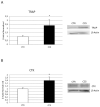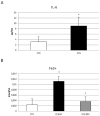Alteration of osteoclast activity in childhood cancer survivors: Role of iron and of CB2/TRPV1 receptors
- PMID: 35862357
- PMCID: PMC9302719
- DOI: 10.1371/journal.pone.0271730
Alteration of osteoclast activity in childhood cancer survivors: Role of iron and of CB2/TRPV1 receptors
Abstract
Childhood cancer survivors (CCS) are predisposed to the onset of osteoporosis (OP). It is known that iron overload induces osteoclasts (OCs) overactivity and that the iron chelator Deferasirox (DFX) can counteract it. The Cannabinoid Receptor type 2 (CB2) and the transient receptor potential vanilloid type-1 (TRPV1) are potential therapeutic targets for OP. In this study we isolated OCs from peripheral blood of 20 CCS and investigated osteoclast biomarkers expression and iron metabolism evaluating iron release by OCs and the expression of several molecules involved in its regulation. Moreover, we analyzed the effects of CB2 and TRPV1 stimulation in combination with DFX on osteoclast activity and iron metabolism. We observed, for the first time, an osteoclast hyperactivation in CCS suggesting a role for iron in its development. Moreover, we confirmed the well-known role of CB2 and TRPV1 receptors in bone metabolism, suggesting the receptors as possible key biomarkers of bone damage. Moreover, we demonstrated a promising synergism between pharmacological compounds, stimulating CB2 or inhibiting/desensitizing TRPV1 and DFX, in counteracting osteoclast overactivity in CCS to improve their quality of life.
Conflict of interest statement
No authors have competing interests.
Figures








Similar articles
-
Effects of CB2 and TRPV1 Stimulation on Osteoclast Overactivity Induced by Iron in Pediatric Inflammatory Bowel Disease.Inflamm Bowel Dis. 2022 Aug 1;28(8):1244-1253. doi: 10.1093/ibd/izac073. Inflamm Bowel Dis. 2022. PMID: 35472140 Free PMC article.
-
PKCβII-mediated cross-talk of TRPV1/CB2 modulates the glucocorticoid-induced osteoclast overactivity.Pharmacol Res. 2017 Jan;115:267-274. doi: 10.1016/j.phrs.2016.11.039. Epub 2016 Dec 2. Pharmacol Res. 2017. PMID: 27919827
-
Iron overload causes osteoporosis in thalassemia major patients through interaction with transient receptor potential vanilloid type 1 (TRPV1) channels.Haematologica. 2014 Dec;99(12):1876-84. doi: 10.3324/haematol.2014.104463. Epub 2014 Sep 12. Haematologica. 2014. PMID: 25216685 Free PMC article.
-
The Endocannabinoid/Endovanilloid System in Bone: From Osteoporosis to Osteosarcoma.Int J Mol Sci. 2019 Apr 18;20(8):1919. doi: 10.3390/ijms20081919. Int J Mol Sci. 2019. PMID: 31003519 Free PMC article. Review.
-
Pharmacological actions of cannabinoids.Handb Exp Pharmacol. 2005;(168):1-51. doi: 10.1007/3-540-26573-2_1. Handb Exp Pharmacol. 2005. PMID: 16596770 Review.
Cited by
-
Effects of a second iron-dextran injection administered to piglets during lactation on differential gene expression in liver and duodenum at weaning.J Anim Sci. 2024 Jan 3;102:skae005. doi: 10.1093/jas/skae005. J Anim Sci. 2024. PMID: 38219027 Free PMC article.
-
Role of Nutraceuticals in Counteracting Inflammation in In Vitro Macrophages Obtained from Childhood Cancer Survivors.Cancers (Basel). 2024 Feb 8;16(4):714. doi: 10.3390/cancers16040714. Cancers (Basel). 2024. PMID: 38398105 Free PMC article.
-
Childhood Cancer Survivors: An Overview of the Management of Late Effects.Cancers (Basel). 2023 Jun 11;15(12):3150. doi: 10.3390/cancers15123150. Cancers (Basel). 2023. PMID: 37370760 Free PMC article.
-
CB2 Receptor as Emerging Anti-Inflammatory Target in Duchenne Muscular Dystrophy.Int J Mol Sci. 2023 Feb 7;24(4):3345. doi: 10.3390/ijms24043345. Int J Mol Sci. 2023. PMID: 36834757 Free PMC article.
References
Publication types
MeSH terms
Substances
LinkOut - more resources
Full Text Sources
Medical
Miscellaneous

